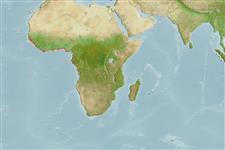Common names from other countries
Environment: milieu / climate zone / depth range / distribution range
Ecologie
marien; zoet water; brak water benthopelagisch. Tropical; 22°C - 26°C (Ref. 2059); 16°N - 12°S, 17°W - 16°E
Africa: coastal basins, fresh waters, brackish and marine waters from mouth of Senegal River (Senegal) to mouth of the Cuanza River (Angola) (Ref. 81260), sometimes ascending far up rivers.
Lengte bij maturiteit / Grootte / Gewicht / Leeftijd
Maturity: Lm 13.5, range 10 - ? cm
Max length : 30.0 cm SL mannelijk / geslacht onbekend; (Ref. 31256)
Dorsale stekels (totaal): 14 - 16; Dorsale zachte stralen (totaal): 12-13; Anale stekels 3; Anale zachte stralen: 8 - 10. Diagnosis: upper profile of head strongly convex; lower pharyngeal bone about as long as broad, and with anterior lamella shorter than toothed area (Ref. 53405). 10 or fewer rakers on lower limb of first arch; unpaired fins not predominantly red-brown; mouth terminal; 29-30 scales on lateral line; outer row teeth robust (Ref. 81260). Dorsal fin with 14-16 spines and 12-13 soft rays (total rays 27-29) (Ref. 53405, 81260). Anal fin with 3 spines and 8-10 soft rays; caudal fin weakly covered with scales at base or entirely membranous (Ref. 81260). Caudal without spots, grey on upper lobe, yellow on lower; large vertical stripes weakly pronounced on flanks; flank scales with a blackish mark at base (Ref. 53405, 81260). No bifurcated dark vertical bars on flanks; dorsal and anal without orange-red upper margin (Ref. 53405). Length of caudal peduncle 10.5-12.9% of standard length (Ref. 81260).
Very tolerant of elevated salinities, found in pure seawater, even reproduction in these highly saline environments is possible (Ref. 52307). Feeds on shrimps, bivalves, plankton (Ref. 28587), detritus (Ref. 28587, 52307), higher plants, algae, aufwuchs and small crustaceans (Ref. 52307). Oviparous (Ref. 205). Very prolific, spawning up to every 3 weeks (Ref. 52307). Pair bonding, open (Ref. 52307) substrate brooder/spawner (Ref. 52307, 81260) with both parents guarding the brood (Ref. 52307).
Oviparous (Ref. 205). Subtrate guarding of eggs as a form of parental care is done by both male and female (Ref. 50828).
Dunz, A.R. and U.K. Schliewen, 2013. Molecular phylogeny and revised classification of the haplotilapiine cichlid fishes formerly referred to as "Tilapia". Mol. Phylogenet. Evol. 68(1):64-80. (Ref. 93285)
Status op de Rode Lijst van het IUCN (Ref. 130435)
CITES (Ref. 128078)
Not Evaluated
Gevaar voor de mens
Harmless
Gebruik door de mens
Visserij: commercieel; Aquacultuur: commercieel
Tools
Speciale rapporten
Download XML
Internetbronnen
Estimates based on models
Preferred temperature (Ref.
115969): 25.5 - 28, mean 27.4 (based on 152 cells).
Fylogenetische diversiteitsindex (Ref.
82804): PD
50 = 0.5000 [Uniqueness, from 0.5 = low to 2.0 = high].
Bayesian length-weight: a=0.01514 (0.00942 - 0.02431), b=2.96 (2.83 - 3.09), in cm Total Length, based on LWR estimates for this species & (Sub)family-body (Ref.
93245).
Trofisch niveau (Ref.
69278): 2.8 ±0.33 se; based on food items.
Weerstandsvermogen (Ref.
120179): Hoog, minimale populatieverdubbelingstijd minder dan 15 maanden (K=0.47; Fec < 1,000).
Fishing Vulnerability (Ref.
59153): Low vulnerability (19 of 100).
